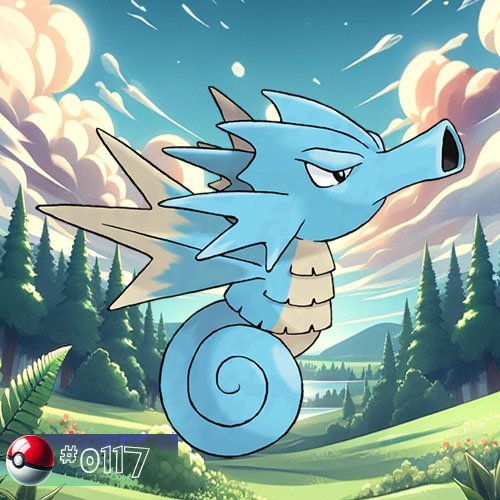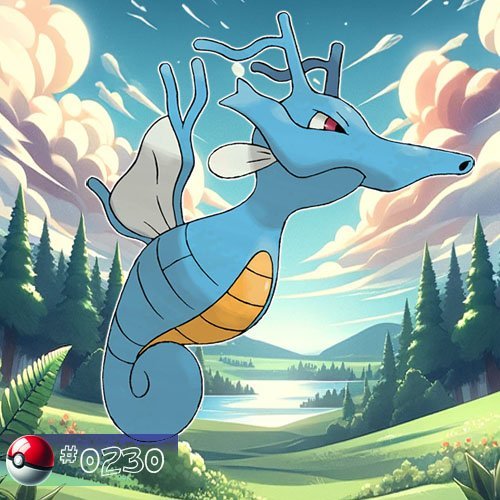Seadra
Seadra is a Water-type Pokémon, the evolved form of Horsea and evolves into Kingdra when traded holding a Dragon Scale. Seadra resembles a seahorse and is known for its elegant swimming abilities and sharp finned tail, which it uses for powerful attacks.

| National Pokedex No: 0117 |
| Type: |
| Category: Dragon Pokémon |
| Height: 1.2 m (3′11″) |
| Weight: 25.0 kg (55.1 lbs) |
| Gender: 50% ♂, 50% ♀ |
| Abilities/Hidden abilities: Poison Point or Sniper/Damp |
Biology
Physical Characteristics
Seadra is a Pokémon that has distinctive physical characteristics. Seadra’s body is slender and elongated, resembling that of a seahorse. This streamlined shape aids in swift and agile movements underwater. The primary color of Seadra’s body is a vibrant shade of blue, contributing to its aquatic theme. The coloration may vary slightly between individuals.
Seadra possesses several dorsal and pectoral fins, contributing to its aquatic prowess. It features several dorsal fins running along its back. These fins may be used for stability and steering while swimming. Seadra has distinct pectoral fins on its sides, providing additional control in the water. Sharp spurs are present on Seadra’s back, possibly serving a defensive purpose.
The tail of Seadra is a notable feature, ending in a curled, fan-like fin. This tail structure aids in propulsion and maneuverability, allowing Seadra to navigate effectively.
Seadra’s head is characterized by an elongated snout, reminiscent of a seahorse. This specialized snout may be adapted for precise aiming and capturing prey. Seadra’s eyes are large and red, providing a keen sense of vision. The red coloration adds a striking contrast to its blue body and gives it a focused and determined appearance.
These intricate physical traits collectively showcase Seadra’s adaptation to an aquatic lifestyle, emphasizing both grace and functionality in its design.
Behaviour
Seadra exhibits several behaviors influenced by its aquatic habitat and evolutionary traits. Here are detailed aspects of Seadra’s behavior.
Seadra is a Water-type Pokémon, indicating its preference for aquatic environments. It is well-adapted to life underwater, showcasing agility and speed in its movements. Seadra is an excellent swimmer, utilizing its streamlined body and specialized fins for efficient navigation through water. Its tail, in particular, allows for precise and rapid movements.
Seadra possesses sharp spurs on its back, which may serve a defensive purpose. It likely employs these spurs as a deterrent against potential threats, deterring predators or rival Pokémon. As a carnivorous Pokémon, Seadra likely exhibits predatory behaviors when hunting for prey. Its elongated snout suggests a specialized adaptation for aiming and capturing small aquatic organisms.
Seadra may establish territories within its preferred aquatic habitat. It might defend these territories from intruders, especially during the breeding season or when resources are limited.
Seadra is the evolved form of Horsea and the pre-evolution of Kingdra. Its behavior may involve specific rituals or displays during the breeding season, contributing to the continuation of its species.
While specific details about social behavior may vary, Seadra likely engages in interactions with its own species. Socializing could play a role in mating rituals, communication, or cooperative activities.
Seadra, when trained by Pokémon Trainers, may exhibit loyalty, responsiveness to commands, and the ability to form strong bonds with its Trainer. Training can influence Seadra’s behavior and battle tactics.
Understanding Seadra’s behavior provides insights into its role in the Pokémon ecosystem, its interactions with other Pokémon, and how it adapts to both natural and trainer-driven environments.
Evolution
Here are detailed insights into the evolution of Seadra.
Seadra is the evolved form of Horsea, the first stage in its evolutionary line. Horsea is a small, seahorse-like Pokémon that typically inhabits coastal waters. Horsea evolves into Seadra when it reaches a certain level of experience through battles and gaining experience points. The exact level at which Horsea evolves into Seadra can vary across different Pokémon games, usually it is level 32.
Seadra’s evolution is triggered by leveling up, a common mechanism for many Pokémon. As Horsea gains experience in battles, reaches the required level, and undergoes the evolution process, it transforms into Seadra.
The evolution from Horsea to Seadra represents a significant advancement in the Pokémon’s physical characteristics. Seadra gains a more elongated and developed body, larger fins, and distinct spines along its back.
Seadra can undergo a further evolution when exposed to a specific evolutionary item, resulting in the formation of Kingdra. To evolve Seadra into Kingdra, a special item called the Dragon Scale is required. When a Trainer uses a Dragon Scale on Seadra and then trades it, the Pokémon undergoes a unique evolution into Kingdra.
Kingdra is the ultimate evolution in Seadra’s evolutionary line. It is a Water/Dragon-type Pokémon with enhanced features, including a more complex body structure, additional fins, and increased capabilities in battles. Seadra’s evolution into Kingdra through the use of the Dragon Scale introduces an interesting mechanic in the Pokémon world, showcasing the impact of evolutionary items and trade interactions on a Pokémon’s development.
Understanding the evolution of Seadra provides Trainers with valuable insights into its growth, capabilities, and the potential for further advancement into Kingdra, expanding strategic options in battles and exploration.
Appearances
Anime Main Appearances
In both ”Mewtwo Strikes Back” and its remake ”Mewtwo Strikes Back—Evolution”, Mewtwo captured and cloned Fergus’s Seadra. The cloned Seadra later reappeared in ”Mewtwo Returns”. Seadra also had its regular series introduction in ”Round One – Begin!” when Mandi employed it in her initial Indigo Plateau Conference battle. The Seadra faced off against Kingler but was ultimately defeated.
In ”Fit to be Tide”, Cissy, the Gym Leader of the Mikan Island’s Gym, utilized Seadra during Ash‘s target test, displaying a sensitive personality. It faced Squirtle, resulting in a tied match. Seadra later appeared in a flashback in ”A Way Off Day Off”.
In ”The Great Eight Fate!”, Juan’s Seadra was part of his Sootopolis City Water Exhibit. When captured by Team Rocket, Seadra and Juan’s other Pokémon collaborated to escape. In ”Looking Out for Number Two!”, Goh rescued a wild Seadra from a Sharpedo, giving it a Dragon Scale. In return, Seadra helped Goh locate a Kingdra for a Project Mew Trial Mission.
Anime Minor Appearances
In ”Pikachu’s Vacation”, a Seadra was spotted at the Pokémon Theme Park. Seadra sensed a disturbance in ”The Power of One” and appeared in various episodes, including ”Snorlax Snowman” and ”The Legend of Thunder!”.
In ”The Joy of Water Pokémon”, three Seadra lived in Lake Lucid, one receiving special treatment. In ”Pokémon Ranger and the Temple of the Sea”, a Seadra encountered a Manaphy Egg. Multiple Seadra featured in ”Kalos, Where Dreams and Adventures Begin!” and ”I Choose You!”. In ”Alola, Kanto!”, two Seadra were at Professor Oak‘s Laboratory, with one in Lana’s fantasy. Seadra also appeared in ”Legend? Go! Friends? Go!” and ”This Could be the Start of Something Big!”.
A Trainer’s Seadra appeared in the episodes:
- ”Hook, Line, and Stinker” (participated in the annual Seaking Catching Competition)
- ”Pokémon Heroes: Latios & Latias” (participated in the Tour de Alto Mare)
Manga Appearances
Pokémon Adventures
In ”Sea Sea Seadra”, a Seadra initially attacked Bill in Viridian Forest. Using Pika’s assistance, Yellow managed to rescue Bill from a Whirlpool created by Seadra and later released the Pokémon after healing it.
Silver’s Seadra evolved from Horsea after being given back by Green. During ”Ampharos Amore”, Silver traded Seadra to Gold for Poliwhirl, leading to its evolution into Kingdra. The evolved Kingdra was shown in a battle against Sudobo during the Tyranitar War.
In ”Debonaire Dragonair”, Ryu, one of Clair’s disciples, used a Seadra in a training battle against Clair, but it was defeated by Clair’s Dragonair.
Game data
Stats
Location
| Game version | Location |
|---|---|
| Pokémon Red | Route 23, Seafoam Islands, Cerulean Cave |
| Pokémon Blue | Route 23 and Cerulean Cave |
| Pokémon Yellow | Routes 12 and 13 |
| Pokémon Gold and Pokémon Silver | Whirl Islands |
| Pokémon Crystal | Whirl Islands |
| Pokémon Ruby and Pokémon Sapphire | Evolve Horsea |
| Pokémon FireRed | Routes 19, 20 and 21, Kindle Road, Treasure Beach, Bond Bridge, Resort Gorgeous, Water Labyrinth, Five Isle Meadow, Memorial Pillar, Green Path, Water Path, Outcast Island, Trainer Tower, Tanoby Ruins, Cinnabar Island, One Island, Five Island, Icefall Cave, Pallet Town |
| Pokémon LeafGreen | Evolve Horsea |
| Pokémon Emerald | Evolve Horsea |
| Pokémon Colosseum | Trade |
| Pokémon XD | Trade |
| Pokémon Diamond and Pokémon Pearl | Route 226 |
| Pokémon Platinum | Route 226 |
| Pokémon HeartGold and Pokémon SoulSilver | Whirl Islands, Seafoam Islands |
| Pokémon Black and Pokémon White | Routes 17 and 18, P2 Laboratory |
| Pokémon Black 2 and Pokémon White 2 | Routes 17 and 18, P2 Laboratory |
| Pokémon X and Pokémon Y | Ambrette Town, Cyllage City |
| Pokémon Omega Ruby and Pokémon Alpha Sapphire | Routes 130, 131, 132, 133 and 134 |
| Pokémon Sun and Pokémon Moon | Evolve Horsea |
| Pokémon Ultra Sun and Pokémon Ultra Moon | Evolve Horsea |
| Pokémon: Let's Go, Pikachu! and Pokémon: Let's Go, Eevee! | Routes 11, 12 and 13 |
| Pokémon Sword and Pokémon Shield | Trade |
| Pokémon Brilliant Diamond and Pokémon Shining Pearl | Route 226 |
| Legends Arceus | Unobtainable |
| Pokémon Scarlet and Pokémon Violet | Trade |
Seadra's origin name
Seadra’s name originates from a combination of the words “sea” and “dragon,” reflecting its aquatic nature and the dragon-like features it gains upon evolution.
English: Seadra is the English name used for this Pokémon. It combines the terms “sea,” denoting its habitat, and “dragon,” highlighting its dragon-like characteristics.
Japanese: In Japanese, Seadra is written as シードラ, which is transliterated as “Shīdora.” The Katakana characters are used to represent the English name, maintaining a similar pronunciation.
French: In French, Seadra is known as “Hypotrempe.” The name incorporates elements like “hippocampe” (seahorse) and “trempe” (soak), emphasizing its water-type nature.
German: The German name for Seadra is “Seemon,” blending “See” (sea) and “Mond” (moon). It refers to the seahorse’s connection to the sea and its crescent moon-shaped crest.
Spanish: Seadra is called “Seadra” in Spanish, maintaining the same name as its English counterpart.
Italian: In Italian, Seadra is referred to as “Seadra,” aligning with the English name and emphasizing its connection to the sea.
Korean: The Korean name for Seadra is 시드라, written as “Sideura.” It closely follows the English pronunciation.
Chinese Simplified (Mandarin): Seadra is known as 海刺龙 (Hǎicìlóng) in Mandarin Chinese. The name translates to “sea spike dragon,” emphasizing its sea-dwelling nature and dragon-like appearance.
Chinese Traditional (Cantonese): In Cantonese, Seadra’s name is written as 海刺龍 (Hói chi lùhng), similar to the Mandarin version but following Cantonese pronunciation.
These variations in Seadra’s name across languages often incorporate elements related to the sea, dragons, or seahorses, providing linguistic nuances while maintaining a thematic connection to its characteristics.




